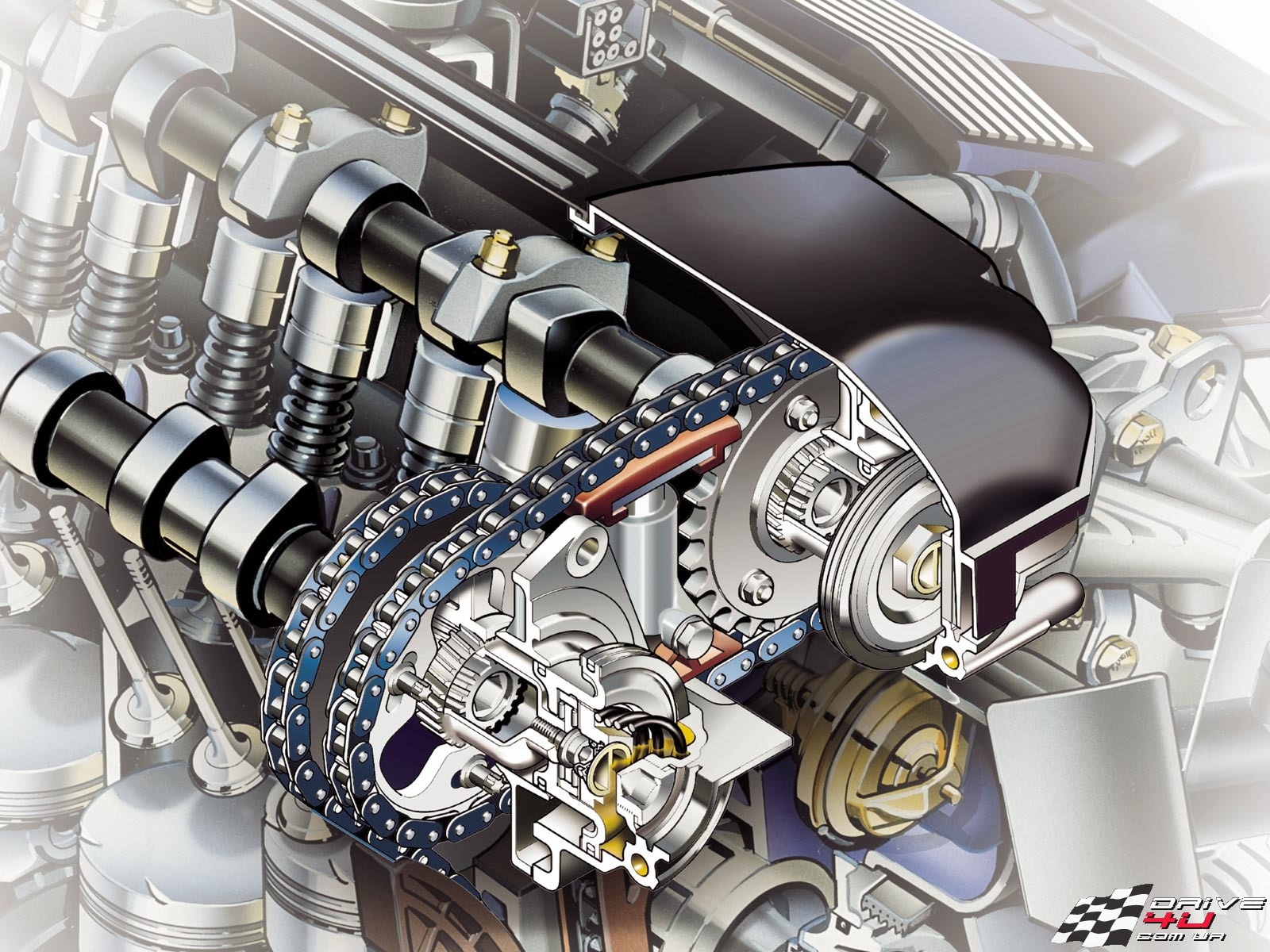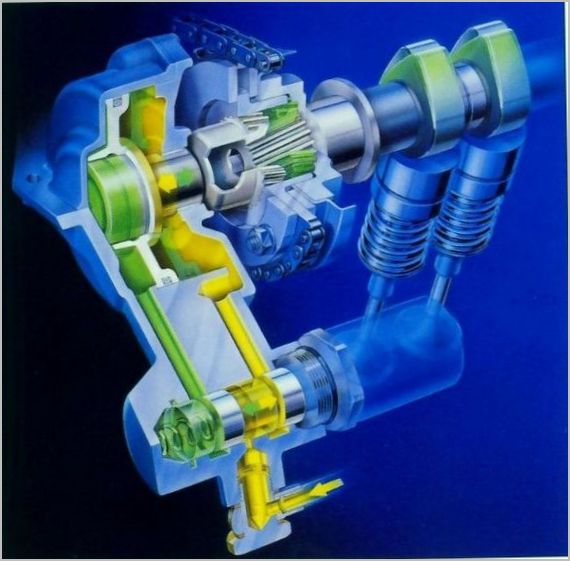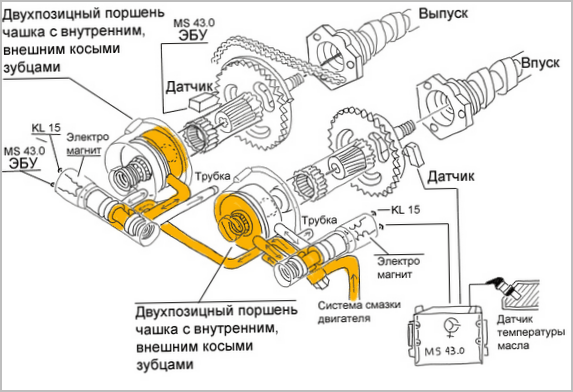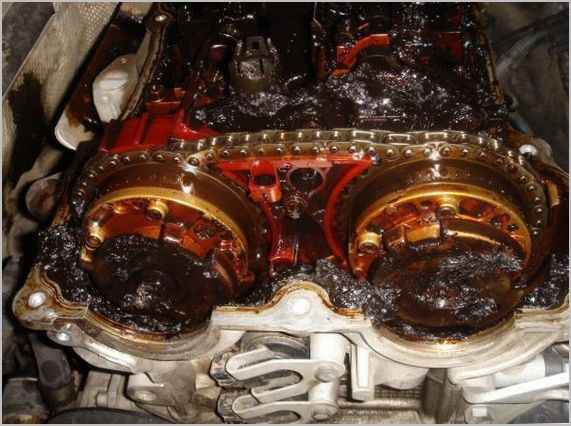
What is the VANOS system from BMW, how does it work
Content
The VANOS (Variable Nockenwellen Steuerung) system is an important component of modern BMW engines, thanks to which it is possible to significantly reduce exhaust emissions, reduce fuel consumption, increase engine torque at low revs and increase maximum power at high revs. This system will allow the engine to run as stable as possible at idle, even at low temperatures.
What is the Vanos system

Variable Nockenwellen Steuerung is German for variable control of engine camshafts. This system was invented by BMW engineers. VANOS is essentially a variable valve timing system. Its peculiarity lies in the fact that it is able to change the position of the camshafts relative to the crankshaft. Thus, the phases of the gas distribution mechanism (GRM) are regulated. This adjustment can be made from 6 degrees ahead to 6 degrees retarded from top dead center.
The device and the main elements of Vanos

The VANOS system is located between the camshaft and the drive gear. Its design is relatively simple. The main part of the system is pistons that change the position of the camshafts, thereby changing the valve timing. These pistons interact with the camshaft gears through a toothed shaft that connects to the piston. These pistons are driven by oil pressure.
The device includes a special solenoid valve, the operation of which is controlled by an electronic control unit (ECU). Information from the camshaft position sensors is taken as input. This sensor determines the current angular position of the shafts. The received data is then sent to the ECU to compare the obtained value with a given angle.
Due to these changes in the position of the camshafts, the valve timing changes. As a result, the valves open a little earlier than they should, or a little later than in the initial position of the shafts.
The principle of the system
BMW is currently using fourth generation VANOS (variable camshaft control) technology in its engines. It should be noted that the first generation of this technology was called Single VANOS. In it, only the intake camshaft was regulated, and the exhaust phases were changed in steps (discretely).
The essence of the operation of such a system was as follows. The position of the intake camshaft was corrected based on data from the engine speed sensor and the position of the accelerator pedal. If a light load (low RPM) was applied to the engine, the intake valves started to open later, which in turn makes the engine run smoother.

Early opening of the intake valves at mid-range engine speeds increases torque and improves exhaust gas circulation in the combustion chamber, reducing fuel consumption and overall emissions. At high engine speeds, the intake valves open later, resulting in maximum power. In the first minutes after starting the engine, the system activates a special mode, the main thing in which is to minimize the warm-up time.
Now the so-called Double Vanos (Double Vanos) is used. Unlike the "Single" system, the double regulates the operation of the intake and exhaust camshafts and their control is smoother. Through the use of an updated system, it was possible to significantly increase the torque and engine power throughout the entire rev range. In addition, according to the BiVanos scheme, a small part of the exhaust gases can be re-burned in the combustion chamber, which, accordingly, leads to an increase in the environmental friendliness of the engine.
Now all cars of the German brand use the fourth generation Vanos system. The main feature of this version is that it uses Vanos gears for the intake and exhaust camshafts. BMW engineers have made the system more compact: now the entire actuator is located in the timing sprockets themselves. Well, in general, the fourth generation of the system is fundamentally similar to Single Vanos.
Advantages and disadvantages of Vanos
With all their undeniable advantages: higher engine torque at low revs, stabilization of the engine at idle, high fuel efficiency and high environmental friendliness, VANOS systems also have disadvantages. She's not reliable enough.
The main malfunctions of Vanos
- Destruction of sealing rings. These are oil piston rings that regulate the position of the camshafts. Due to many factors: high and low temperatures, various harmful substances that enter the rubber (the material from which the rings are made), it eventually begins to lose its elastic properties and crack. That is why the tightness inside the mechanism disappears.
- Worn washers and bearings. The design of oil pistons includes metal bearings and washers. Over time, they begin to deform, as they initially have a low margin of safety. To determine if a bearing (or washer) needs to be replaced in a VANOS system, you need to listen to how the engine is running. If the bearing or washer is worn, an unpleasant, metallic noise is heard.
- Chips and dirt on flanges and pistons. This is the so-called deformation of metal parts. It can be caused by a rather aggressive driving style, low-quality oil / gasoline, as well as high mileage. Notches and scratches appear on the surface of oil pistons or gas camshafts. The result is loss of power/torque, unstable engine idling.

If the car engine begins to vibrate at idle, you notice rather weak acceleration throughout the entire rev range, there is an increase in fuel consumption, rattling noises during engine operation, most likely the VANOS needs urgent attention. Problems starting the engine, spark plugs and bumps are a clear sign of poor system performance.
Despite the unreliability, the development of the Bavarian engineers is very useful. Through the use of VANOS, improved engine performance, economy and environmental compatibility are achieved. Vanos also smooths out the torque curve throughout the engine's operating range.
